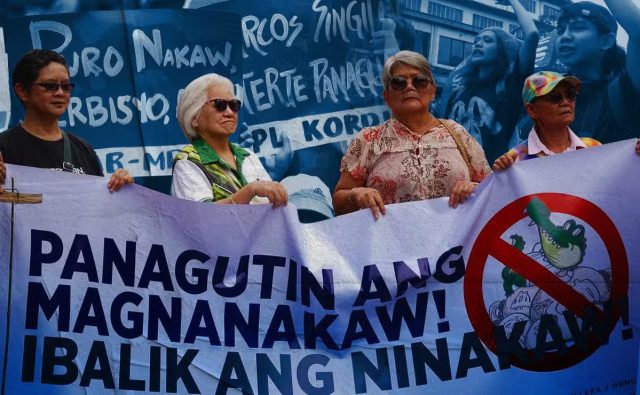MANILA, Philippines — More than 30,000 Filipinos were expected to flood the streets of Manila and beyond on Sunday in a massive anti-corruption protest dubbed the “Trillion Peso March,” demanding accountability for alleged graft in government-funded flood control projects that have sparked widespread outrage.
The first main protest will be held in Manila at 9 a.m., where the country’s national hero, Jose Rizal, was executed on Dec. 30, 1986, with Taumbayan Ayaw sa Magnanakaw at Abusado Network Alliance (Tama Na) as the lead organizer of the gathering.
The protest “Baha sa Luneta,” was planned at nearby Luneta Park, drawing youth, activists, artists and flood victims. — led by youth and activist groups — will be attended by notable personalities who endorsed it, including Kabataan Rep. Renee Co, San Carlos Bishop Gerardo Alminaza, Sr. Mary John Mananzan, film director Joel Lamangan, former Bayan Muna Rep. Teddy Casiño, and Karapatan Secretary General Cristina Palabay.
A separate but allied event, organized by a coalition of church groups, civil society organizations, labor unions and political alliances, the demonstrations aimed to highlight what protesters called the plundering of trillions of pesos in public funds. The main rally was set to converge at the People Power Monument along EDSA highway in Quezon City, with marchers gathering from 8 a.m. and arriving en masse by 2 p.m.
“We’re calling for accountability for all cases of corruption across all branches of government and all past and present administrations,” said Kiko Aquino-Dee, a co-convenor of Tindig Pilipinas, one of the key organizers. He added that protesters sought “legal accountability: strong cases filed, jail time, and a guilty verdict,” along with political repercussions, urging voters to “kick the rascals out in 2028.”
Aquino-Dee emphasized the rallies’ peaceful nature, discouraging support for any political agendas or violence. Participants were encouraged to wear white, symbolizing unity and purity against corruption, with white ribbons as a common emblem.
The Catholic Bishops’ Conference of the Philippines endorsed the protests, framing them as a “moral stand” rather than a political maneuver. “It is a moment of prayer, solidarity and action against the entrenched culture of corruption that robs our people of dignity, deepens poverty, and betrays our future,” CBCP President Pablo Virgilio Cardinal David said in a statement. He invited Filipinos nationwide to join local prayer rallies in solidarity.
Labor groups, including the Nagkaisa Labor Coalition, echoed the call, decrying the “abominable” diversion of funds meant for infrastructure. “These repeated acts are shocking to conscience and must end — and end now,” the coalition said.
A pro-Duterte group, Hakbang ng Maisug, scheduled its own rally at Liwasang Bonifacio starting at 1 p.m., led by former executive secretary Victor Rodriguez, to voice outrage over “shameless plunder” without aligning with the main events.
Protests extended beyond the capital. In Cebu, Catholic schools like Saint Theresa’s College and the University of San Carlos urged participation in prayer rallies and symbolic acts, such as wearing white on Monday. In Pampanga, about 1,000 demonstrators from youth, civic and business groups planned a march in Angeles City to “jail the corrupt,” coinciding with the anniversary of martial law declaration under former President Ferdinand Marcos Sr.
President Ferdinand Marcos Jr. acknowledged public frustration, affirming the right to peaceful assembly while urging lawfulness. The Philippine National Police deployed over 50,000 officers nationwide, with acting chief Lt. Gen. Jose Melencio Nartatez Jr. promising “maximum tolerance” but firm action against disorder.
Malacañang cautioned against exploitation of the rallies to discredit the government, with Palace Press Officer Claire Castro reminding the public to vigilance. The U.S. and French embassies issued alerts advising their citizens to avoid demonstration areas due to potential violence. “Even peaceful demonstrations have the potential to turn violent without warning,” the U.S. Embassy said.
Manila Mayor Francisco “Isko Moreno” Domagoso said he would personally oversee safety operations from 4 a.m., with road closures along Roxas Boulevard and nearby streets. The Metropolitan Manila Development Authority advised motorists to use alternate routes.
Health Secretary Ted Herbosa warned of crowd-related risks like stampedes, urging participants to bring water, masks, medications and check weather forecasts. “When you have many people in one place, there’s a health risk,” he said.
Political analyst Ronald Llamas predicted a diverse crowd, including first-time protesters. “It will be a mixture of old and new ones,” he said, expressing hope for follow-through on Marcos’ initial actions against those implicated.
Organizers tied the protests to broader demands, including empowering the Independent Commission for Infrastructure with contempt powers to investigate high officials. Aquino-Dee criticized efforts to downplay past administrations’ scandals, particularly under Rodrigo Duterte, and linked the timing to martial law’s anniversary.














